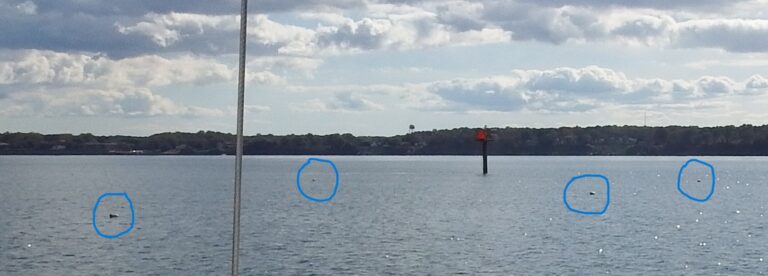https://www.youtube.com/watch?v=NxU-kkiYFeU
People ask, “Is it difficult to buy a sailboat?” No, and you can do it yourself without a broker. At Let’s Go Sail, the Boat Buying Cruise is for those who are determined to own their own sailboat. Unless they’re flush with cash, I recommend buying used. For one thing, the engine is already broken in and presumably everything else as welll. That’s not always the case with new.
 Lots of boats are listed on the market, privately by owner and commercially with boat brokerages. As with cars, the rise of the internet has smoothed out prices to the point that it’s difficult to “steal” a boat. By the same token, prices are generally fair and you won’t pay too much. To steal a boat, you have to lowball the offer. Sometimes that works, especially for desperate sellers on a rainy day in January. That raises two questions: Why is he or she desperate? Is it the condition of the boat?
Lots of boats are listed on the market, privately by owner and commercially with boat brokerages. As with cars, the rise of the internet has smoothed out prices to the point that it’s difficult to “steal” a boat. By the same token, prices are generally fair and you won’t pay too much. To steal a boat, you have to lowball the offer. Sometimes that works, especially for desperate sellers on a rainy day in January. That raises two questions: Why is he or she desperate? Is it the condition of the boat?
Unlike the residential real estate market, there is no such thing as a buyer’s broker. It’s just a boat, not a house. You simply have to do a little price comparison in the range of size or price that you’re looking at. Rules of thumb (1) The older the boat, the less the price; (2) The bigger the boat, the higher the price. No surprise there.
Surveyor or not?
You can hire a surveyor to check out your finalist boat, but be prepared to pay $800 or more depending on the size and length. An alternative is to take a knowledgeable sailor/mechanical friend to spend an hour looking over the boat, kicking the tires so to speak. The surveyor will find so many things wrong with the boat that you’ll wonder why you even bothered. It’s like running a credit check on your second fiancé. You’re better off not knowing the awful details. Stick with the willing friend. Ask him to rate the degree of any discovered flaw: Cosmetic, Minor, Major, Deal-killer. Surveyors won’t do that; they are antiseptically objective to the point of madness.

First impressions matter. If it looks like a fixer-upper, it’s a fixer-upper. If it looks pristine, someone has taken good care of the boat. Naturally you’ll want to take it for a test drive, but not so fast. Boat brokerages require a signed contract and down payment, to avoid joy riders. Private sellers are more likely and eager to take you out for free to show you her speed and maneuverability.
The checklist below is hardly exhaustive, but it will disclose a lot of defects. The list is broken into three main categories: Above the boat, Inside the boat, Below the Boat. The boat is assumed to be diesel operated inboard and can be viewed on “the hards,” that is out of the water on jack stands. Some of the terms may seem obscure to the prospective buyer, but the willing friend will know what they mean.
ABOVE THE BOAT
Standing Rigging
-
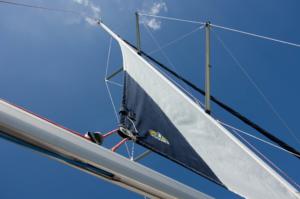 Mast — Straight, clean, devoid of dents or gashes
Mast — Straight, clean, devoid of dents or gashes -
Boom — Clean, with boom kicker, tightly attached
-
Shrouds — Smooth, tightly attached, rust-free chain plates
-
Rails — Rust-free, tightly bedded to deck, lifelines tight
-
Remember — Buying a sailboat? Do it yourself
Sails
-

Spinnakers tear easily. Main — Clean, crisp, no threads, no stains, firm belly
-
Jib — Winds easily into furler, looks clean and flat
-
Genoa — Same as jib, extends 20% behind the mast
-
Spinnaker — Free of tears, packed in chute, clean and bright
Running Rigging
-
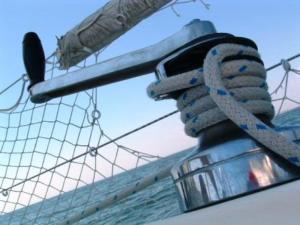 Sheets — Lines bright, clean, free of mold, no fraying
Sheets — Lines bright, clean, free of mold, no fraying -
Halyards — Same as Sheets and flow through blocks well
-
Sheaves — Intact, bright, smooth wheel movement
INSIDE THE BOAT
-
Engine — Clean, starts easily, little or no smoke, reaches 80% of rated RPM
-
Drive Shaft — No nicks or rust, turns easily
-
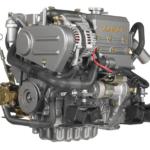
Clean engine is a good sign of owner care. Stuffing Box — Tightly wound to allow few water drips. No drips? Fine.
-
Transmission — Clean oil, no plastic parts (as found on Beneteaus)
-
Muffler — No exterior leaks or internal corrosion
-
Mixing Elbow — Replaced within 5 years, check water flow
-
Fuel Filters — Replaced annually, no sign of crud in jar
-
Helm — Feels tight, moves easily, looks shipshape
-
Cockpit — Clean, no snags, no nicks, easy to move around
-
Fiberglass — Shiny, or at least free of chalky oxidation
-
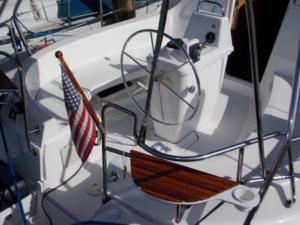 Catbirds — Bright work (wood) well varnished
Catbirds — Bright work (wood) well varnished -
Pedestal — Easy to work around, comes with cup holders
-
Screws — All intact, tightly wound, no rust drips
-
Head — Smells clean, toilet clean, uncluttered. Test it.
-
Salon — No black signs or smell of mold, implies leaks. Look up to see if the ceiling is clean and non-sticky.
BELOW THE BOAT (Buying a Sailboat? Do it Yourself.)
-
Bottom Paint — Consistent everywhere, no blisters
-
Prop Paint — Residue apparent of attempts to preserve
-
Prop Dings — Dings, cuts and bending imply damage
-
Keel Paint — Missing point underneath implies aground
-
Keel Damage — Bent or dinged suggests ran aground
-
Zincs — Intact on shaft, usually need routine replacement
-
Drain Openings — Free and clear, test from Salon with water
-
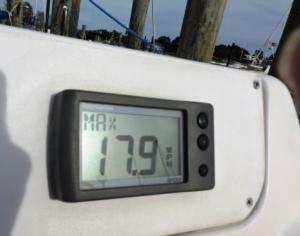
Check the speedometer. Speedometer — Works accurately. Flanges clean, painted.
-
Depth Meter — Smooth surface, unpainted. Test in slip.
-
Oxidized Hull — Requires compounding before waxing
-
Fiberglas Dings — Implies damage while docking
-
Rubrail — Smooth, clean and totally intact
-
Stern Ladder — Flexible, rust-free and telescopes easily
Buying a Sailboat? Do it Yourself.
Scroll down Rates and pick a day for a sailboat charter. Scroll down Reviews on Trip Advisor. Go back to the Home Page of Williamsburg Charter Sails.
buying a sailboat do it yourself buying a sailboat do it yourself buying a sailboat do it yourself



